Next year's garden may seem far away, but you can get it off to a great start by planting spectacular bulbs this fall. Some add much-anticipated color to the bare winter landscape, others jazz up summer borders, and still others bloom into fall. Many of these choices will slowly naturalize if left to drift casually through beds and borders. In moist, well-drained soil, colonization often comes more rapidly.
Overall, bulbs make few demands other than well-drained soil. Simply dig a hole in an appropriate location, plant according to package directions, add a light sprinkling of 10-10-10 fertilizer, water, and forget about it. The bulbs will take it from there and delight you with their colorful surprise.
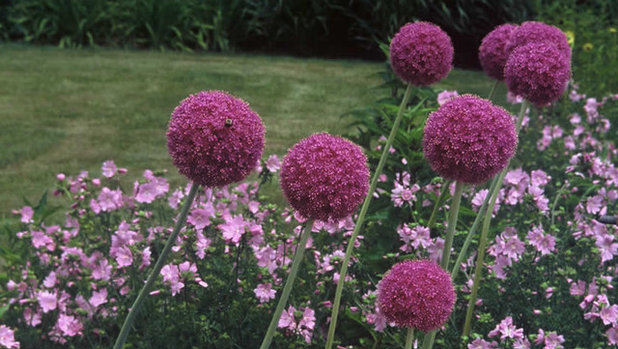
Clinton & Associates, PC Landscape Architects
Ornamental OnionsAllium Simultaneously playful and architectural, these oval, spherical, or globular flower shapes are a versatile addition to any garden. Plus, they're deer resistant and drought tolerant, and they come in great colors. Sizes vary greatly by variety, and bloom times range from spring to summer to fall.
There are many notable favorite ornamental onions, including 'Globemaster' (pictured here) with its huge purple spheres on 3- to 4-foot stems. Mix it with other early summer plantings in shades of pink and purple, such as roses, peonies, iris, dianthus and cranesbill geranium. Another favorite is the yellow allium
(allium flavum), a midsummer bloomer that grows up to 2 feet high and offers clusters of yellow, pink or white florets.
USDA zones: 5 to 10 (find your zone)
Sun requirement: Full to partial shade
Height: 1 to 4 feet
Bloom time: Spring, summer or fall
Planting tips: Plant a little deeper than other bulbs, about three times the dimension of the bulb.
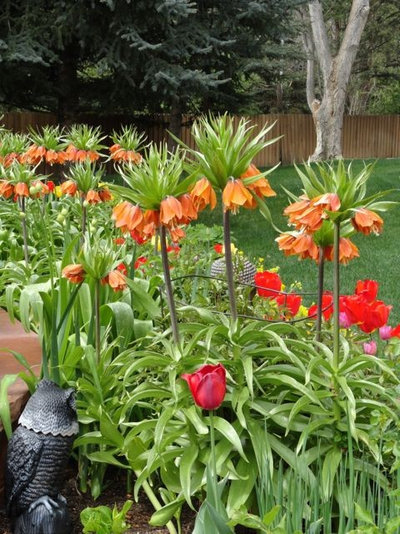
B. Gardening Landscape Design
Crown ImperialFritillaria imperallisThe showiest member of the fritillaria family, the crown imperial is an exotic-looking plant that produces clusters of pendulous 4-inch orange, yellow or red blooms beneath a spiky crown of green leaves. Plant in groupings and conceal dying foliage with leafy companion plants, such as ornamental grasses, ferns and hostas. Deer-resistant, the crown imperial's leaves emit a skunklike odor when crushed.
USDA zones: 3 to 8
Sun requirement: Full to partial shade
Height: 2 to 4 feet
Bloom time: April and May
Planting tips: Plant quickly to prevent drying out. Tip the bulb or place on its side to keep water from pooling in the top indent.
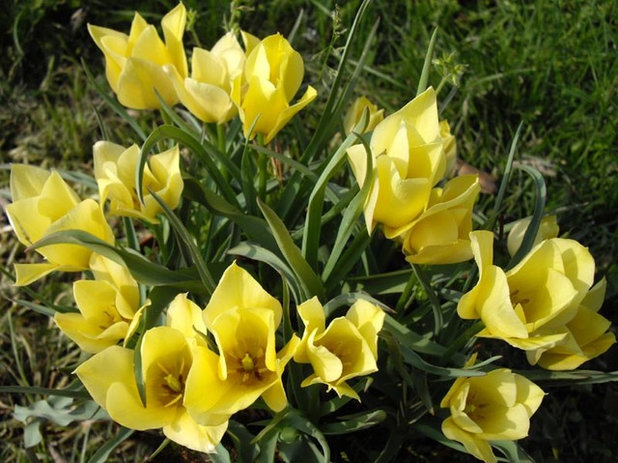 Botanical TulipsSpecies tulips
Botanical TulipsSpecies tulipsOften overshadowed by their taller cousins, species tulips are nevertheless much longer lived. In fact, while hybrid tulips tend to fizzle after a year or two, these wildflower variants frequently multiply if their foliage is allowed to die back naturally. Species tulips add bold color to rock gardens and informal borders. Standouts include cultivars of
Tulipa batalinii, such as the yellow 'Bright Gem' (pictured here) and 'Yellow Jewel'. Good choices for naturalizing include
T. clusiana and the fragrant
T. sylvestris.
USDA zones: 3 to 8
Sun requirement: Full sun, part sun
Height: 4 to 14 inches
Bloom time: April and May
Planting tips: In wet climates, dig and store dormant bulbs to replant in the fall.
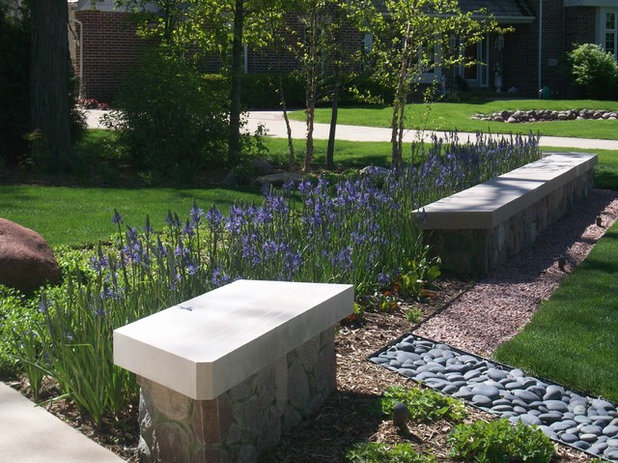
Ginkgo Leaf Studio
Camas, Quamash, Wild HyacinthCamassia These tall stalks with blue or cream flowering racemes look striking in mass. Plant in the middle of borders with daylilies, peonies or hostas that can cover any dying foliage. Camas is also right at home in moist meadows, in woodlands and beside streams where it can naturalize. Notable varieties include 'Blue Danube' (pictured here) and 'Alba', a creamy white.
USDA zones: 3 to 11
Sun requirement: Full sun to light shade
Height: 2 to 4 feet
Bloom time: May and June
Planting tips: Camassia does well in well-drained soil, but it can also thrive in moist soil.
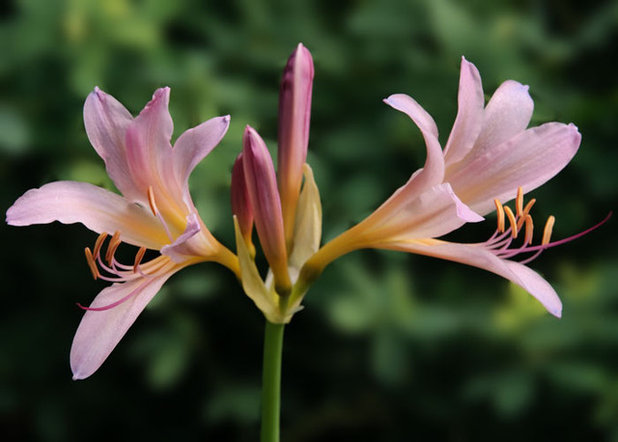
Barbara Pintozzi
Resurrection Lily, Naked Lady Lily, Surprise LilyLycoris squamigeraBlooming after its leaves have withered and disappeared, this trumpet-shaped flower rises from dormancy to make a dramatic late-summer showing. Plant these long-lived members of the amaryllis family in borders or in woodland gardens where they can naturalize.
USDA zones: 5 to 9
Sun requirement: Full sun to part shade
Height: Up to 2 feet
Bloom time: August and September
Planting tips: Bulbs do not like being disturbed and may need a full season to adjust before they bloom.
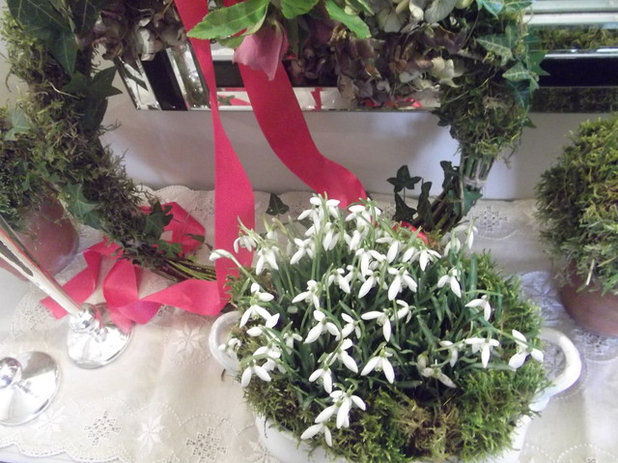
Beertje Vonk Artist
SnowdropGalanthusOne of the earliest harbingers of spring, the delicate-looking snowdrop is tough enough to poke through snow in Northern gardens and to bloom through winter in the South. Snowdrop makes a graceful addition to meadows, beds and borders. If you have snowdrop blooms to spare in spring, consider digging up the flowering bulbs with soil intact to transfer to an indoor container. (The flowers likely won't last as long as they would outdoors, but you will get to enjoy them frequently.)
Favorite varieties include the reliable
Galanthus nivalis that spreads slowly and the bigger-flowered 'Sam Arnott' with heart-shaped green markings.
USDA zones: 3 to 9
Sun requirement: Full sun to full shade, depending on variety
Height: 5 to 12 inches
Bloom time: February and March
Planting tips: Bulbs are fragile, so plant as soon as possible.





